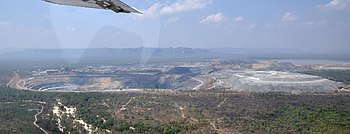Mining of uranium and thorium: Difference between revisions
Pat Palmer (talk | contribs) mNo edit summary |
mNo edit summary |
||
| (12 intermediate revisions by one other user not shown) | |||
| Line 1: | Line 1: | ||
{{ | {{subpages}} | ||
{{Image|Ranger uranium mine aerial view 2009.jpg|right|350px|Aerial view of the Ranger surface uranium mine in 2009. It is located in Kakadu National Park in Australia’s Northern Territory. Mining occurred between 1980 and 2012. Today, many mines are moving away from conventional mining techniques to the ''in situ'' leach approach, which has a smaller surface environmental footprint.}} | |||
'''Mining of uranium and thorium''' today is not that much different from mining any other metal; the uranium itself generally has a very low level of radioactivity. Many uranium mines, especially in Australia and Canada, have ISO 14001 certification, which means they have adopted a set of international standards clarifying best practices for monitoring safety for workers and the environment. | |||
Three-quarters of the world's uranium is mined in Kazakhstan, Canada, Australia and Namibia, with the remainder from another eleven countries. | |||
Often, uranium is now being extracted by ''in situ'' leach methods<ref>[https://world-nuclear.org/information-library/nuclear-fuel-cycle/mining-of-uranium/in-situ-leach-mining-of-uranium.aspx ''In situ'' leach mining of uranium], a tutorial on this kind of mining from the World Nuclear Association</ref>, especially in the USA and Kazakhstan. This method of extraction is cheaper and also is widely seen as better environmentally than traditional mineral extraction methods such as those used in [[coal mining]] | |||
''See also [[Nuclear power reconsidered]].''[[Category:Suggestion Bot Tag]] | |||
Latest revision as of 16:01, 19 September 2024

Mining of uranium and thorium today is not that much different from mining any other metal; the uranium itself generally has a very low level of radioactivity. Many uranium mines, especially in Australia and Canada, have ISO 14001 certification, which means they have adopted a set of international standards clarifying best practices for monitoring safety for workers and the environment.
Three-quarters of the world's uranium is mined in Kazakhstan, Canada, Australia and Namibia, with the remainder from another eleven countries.
Often, uranium is now being extracted by in situ leach methods[1], especially in the USA and Kazakhstan. This method of extraction is cheaper and also is widely seen as better environmentally than traditional mineral extraction methods such as those used in coal mining
See also Nuclear power reconsidered.
- ↑ In situ leach mining of uranium, a tutorial on this kind of mining from the World Nuclear Association